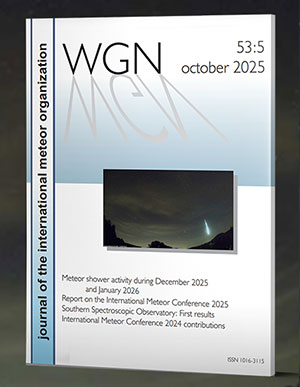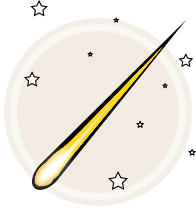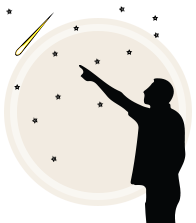As seen from the northern hemisphere, meteor rates continue to be strong in
November. While no major activity is expected this month, the two Taurid
radiants plus the Leonids keep the skies active. The addition of strong sporadic
rates make November one of the better months to view meteor activity from north
of the equator. Skies are fairly quiet as seen from the
southern hemisphere this month. Activity from the three showers mentioned above
may be seen from south of the equator, but the sporadic rates are much lower
than those seen in the northern hemisphere.
During this period the moon reaches its last quarter phase on Wednesday November
7th. At this time the moon is located ninety degrees west of the sun and well
rise near 2300 (11pm) local standard time (LST). This weekend the waning gibbous
moon will rise during the late evening hours and will interfere with meteor
observing the remainder of the night. As the week progresses the moon will rise
later and later, becoming less of a nuisance with each passing night. The
estimated total hourly meteor rates for evening observers this week is near four
for observers located at mid-northern latitudes and three for observers in
mid-southern latitudes. For morning observers the estimated total hourly rates
should be near fourteen from the mid-northern hemisphere and eight from the
mid-southern hemisphere. The actual rates will also depend on factors such as
personal light and motion perception, local weather conditions, alertness and
experience in watching meteor activity. Rates during
the morning hours are reduced this week due to moonlight.
The radiant (the area of the sky where meteors appear
to shoot from) positions and rates listed below are exact for Saturday night/Sunday
morning November 3/4. These positions do not change greatly day to day so the listed
coordinates may be used during this entire period. Most star atlases (available
at science stores and planetariums) will provide maps with grid lines of the
celestial coordinates so that you may find out exactly where these positions are
located in the sky. A planisphere or computer planetarium program is also useful
in showing the sky at any time of night on any date of the year. Activity from
each radiant is best seen when it is positioned highest in the sky, either due
north or south along the meridian, depending on your latitude. It must be
remembered that meteor activity is rarely seen at the radiant position. Rather
they shoot outwards from the radiant so it is best to center your field of view
so that the radiant lies at the edge and not the center.
Viewing there will allow you to easily trace the path of each meteor back to
the radiant (if it is a shower member) or in another direction if it is a
sporadic. Meteor activity is not seen from radiants that are located below the
horizon. The positions below are listed in a west to east manner in order of
right ascension (celestial longitude). The positions listed first are located
further west therefore are accessible earlier in the night while those listed
further down the list rise later in the night.
The following radiants are expected to be active this week:
Remnants from the famous Andromedid (AND) shower, noted for intense storms
during the 19th century, may still be seen throughout November. The current
position of this large radiant is 01:24 (021) +23 . This position lies in
eastern Pisces, ten degrees west of the second magnitude star Hamal (Alpha
Arietis). The radiant is so diffuse that Andromedid meteors may be seen coming
from southern Andromeda, Triangulum, and northwestern Aries as well as eastern
Pisces. Visual activity is expected to be low, but detectable. An inconspicuous
maximum occurs on November 9, when this source is the 5th most active radiant in
the sky. The Andromedid meteors are best seen near 2200 LST, when the radiant
lies on the meridian and lies highest in the sky. At 19km/sec., the average
Andromedid will appear as a very slow moving meteor.
The Northern Taurids (NTA) are active from a large radiant centered at 03:28
(052) +21. This area of the sky lies on the Aries/Taurus border, five degrees
southwest of the famous naked eye open cluster known as the Pleiades or the
Seven Sisters. The radiant is best placed near 0100 LST, when it lies highest
above the horizon. Maximum activity is not expected until November 13, so
current rates would be 2-3 per hour, no matter your location. Meteors from the
Northern Taurids strike the atmosphere at 29km/sec., which would produce meteors
of slow velocity. You must face in the general direction of the north and south
Taurid radiants in order to tell them apart.
The Southern Taurid (STA) radiant is currently located at 03:36 (054) +13. This
position lies in western Taurus, ten degrees south of the famous naked eye open
cluster known as the Pleiades or the Seven Sisters. This radiant is best placed
near 0100 LST, when it lies on the meridian and is located highest in the sky.
Maximum occurred on October 9th, so rates would now be near one per hour when
the radiant lies high in the sky. With an entry velocity of 29 km/sec., the
average Southern Taurid meteor would be of slow velocity.
The Orionids (ORI) are still the second most active shower this upcoming week
producing up to two shower members per hour from a radiant located at 07:04
(106) +16. This area of the sky is located in southern Gemini, five degrees east
of the second magnitude star Alhena (Gamma Geminorum). The radiant is best
placed for viewing near 0400 LST when it lies on the meridian and is highest
above the horizon. Orionid meteors are equally well seen either side of the
equator. With an entry velocity of 67 km/sec., most activity from this radiant
would be swift.
The Leonids (LEO) are actually active in small numbers during the morning hours
in early November. The radiant is currently located at 09:36 (144) +28. This
position lies in northwestern Leo, four degrees northwest of the fourth
magnitude star Mu Leonis. Rates are only one per hour at best but will increase
as the moon exits the morning sky. The Leonid radiant is best placed during the
last hour before morning twilight when the radiant lies highest in a dark sky.
Leonids may be seen from the southern hemisphere but the viewing conditions are
not quite as favorable as those north of the equator.
As seen from the mid-northern hemisphere (45N) one would expect to see
approximately seven sporadic meteors per hour during the last hour before dawn
as seen from rural observing sites. Evening rates would be near three per hour.
As seen from the mid-southern hemisphere (45S), morning rates would be near
three per hour as seen from rural observing sites and two per hour during the
evening hours. Locations between these two extremes would see activity between
the listed figures. Rates during the morning hours are reduced this week due to
moonlight.
The table below presents a condensed version of the expected activity this week.
Rates and positions are exact for Saturday night/Sunday morning.
| SHOWER | DATE OF MAXIMUM ACTIVITY | CELESTIAL POSITION | ENTRY VELOCITY | CULMINATION | HOURLY RATE | CLASS |
| RA (RA in Deg.) DEC | Km/Sec | Local Standard Time | North-South | |||
| Andromedids (AND) | Nov 09 | 01:24 (021) +23 | 19 | 22:00 | 1 – <1 | III |
| Northern Taurids (NTA) | Nov 13 | 03:28 (052) +21 | 29 | 01:00 | 3 – 2 | II |
| Southern Taurids (STA) | Oct 09 | 03:36 (054) +13 | 29 | 01:00 | 1 – 1 | II |
| Orionids (ORI) | Oct 22 | 07:04 (106) +16 | 67 | 04:00 | 2 – 2 | I |
| Leonids (LEO) | Nov 18 | 09:36 (144) +28 | 71 | 06:00 | <1 - <1 | III |




 You saw something bright and fast? Like a huge shooting star? Report it: it may be a fireball.
You saw something bright and fast? Like a huge shooting star? Report it: it may be a fireball.  You counted meteors last night? Share your results with us!
You counted meteors last night? Share your results with us!  You took a photo of a meteor or fireball? You have a screenshot of your cam? Share it with us!
You took a photo of a meteor or fireball? You have a screenshot of your cam? Share it with us!  You caught a meteor or fireball on video? Share your video with us!
You caught a meteor or fireball on video? Share your video with us!